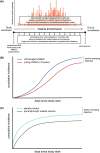Mature beyond their years: young children who escape detection of parasitemia despite living in settings of intense malaria transmission
- PMID: 38752830
- PMCID: PMC11209762
- DOI: 10.1042/BST20230401
Mature beyond their years: young children who escape detection of parasitemia despite living in settings of intense malaria transmission
Abstract
Despite having the highest risk of progressing to severe disease due to lack of acquired immunity, the youngest children living in areas of highly intense malaria transmission have long been observed to be infected at lower rates than older children. Whether this observation is due to reduced exposure to infectious mosquito bites from behavioral and biological factors, maternally transferred immunity, genetic factors, or enhanced innate immunity in the young child has intrigued malaria researchers for over half a century. Recent evidence suggests that maternally transferred immunity may be limited to early infancy and that the young child's own immune system may contribute to control of malarial symptoms early in life and prior to the development of more effective adaptive immunity. Prospective studies of active and passive detection of Plasmodium falciparum blood-stage infections have identified young children (<5 years old) who remain uninfected through a defined surveillance period despite living in settings of highly intense malaria transmission. Yet, little is known about the potential immunological basis for this 'aparasitemic' phenotype. In this review, we summarize the observational evidence for this phenotype in field studies and examine potential reasons why these children escape detection of parasitemia, covering factors that are either extrinsic or intrinsic to their developing immune system. We discuss the challenges of distinguishing malaria protection from lack of malaria exposure in field studies. We also identify gaps in our knowledge regarding cellular immunity in the youngest age group and propose directions that researchers may take to address these gaps.
Keywords: Plasmodium falciparum; cellular immunity; early adaptive immunity; early life immunity; innate immunity; malaria.
© 2024 The Author(s).
Conflict of interest statement
The authors declare that there are no competing interests associated with the manuscript.
Figures

Similar articles
-
Folic acid supplementation and malaria susceptibility and severity among people taking antifolate antimalarial drugs in endemic areas.Cochrane Database Syst Rev. 2022 Feb 1;2(2022):CD014217. doi: 10.1002/14651858.CD014217. Cochrane Database Syst Rev. 2022. PMID: 36321557 Free PMC article.
-
Transmission and Age Impact the Risk of Developing Febrile Malaria in Children with Asymptomatic Plasmodium falciparum Parasitemia.J Infect Dis. 2019 Feb 23;219(6):936-944. doi: 10.1093/infdis/jiy591. J Infect Dis. 2019. PMID: 30307567 Free PMC article.
-
A Malaria-Resistant Phenotype with Immunological Correlates in a Tanzanian Birth Cohort Exposed to Intense Malaria Transmission.Am J Trop Med Hyg. 2017 May;96(5):1190-1196. doi: 10.4269/ajtmh.16-0554. Am J Trop Med Hyg. 2017. PMID: 28500801 Free PMC article.
-
Microscopic and Submicroscopic Asymptomatic Plasmodium falciparum Infections in Ghanaian Children and Protection against Febrile Malaria.Infect Immun. 2020 Sep 18;88(10):e00125-20. doi: 10.1128/IAI.00125-20. Print 2020 Sep 18. Infect Immun. 2020. PMID: 32719157 Free PMC article.
-
The consequences of reducing transmission of Plasmodium falciparum in Africa.Adv Parasitol. 2002;52:235-64. doi: 10.1016/s0065-308x(02)52013-3. Adv Parasitol. 2002. PMID: 12521262 Review.
Cited by
-
Risk Factors for Imported Severe Malaria Cases - China, 2019-2023.China CDC Wkly. 2025 May 2;7(18):602-608. doi: 10.46234/ccdcw2025.100. China CDC Wkly. 2025. PMID: 40376504 Free PMC article.
-
Heterogeneity of the human immune response to malaria infection and vaccination driven by latent cytomegalovirus infection.EBioMedicine. 2024 Nov;109:105419. doi: 10.1016/j.ebiom.2024.105419. Epub 2024 Oct 26. EBioMedicine. 2024. PMID: 39490199 Free PMC article.
References
-
- World Health Organization. (2023) World Malaria Report 2023, World Health Organization, Geneva, Switzerland.
-
- Macdonald, G. (1950) The analysis of malaria parasite rates in infants. Trop. Dis. Bull. 47, 915–938 - PubMed
Publication types
MeSH terms
Grants and funding
LinkOut - more resources
Full Text Sources

